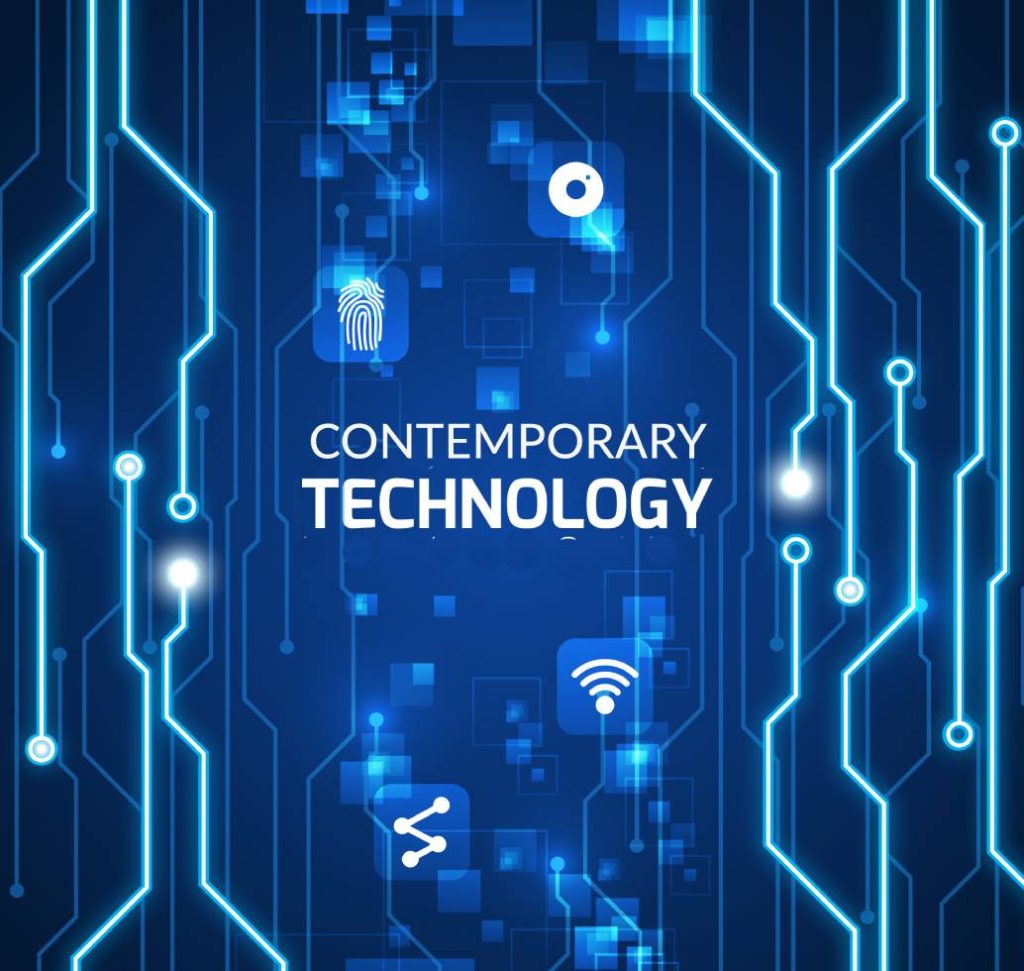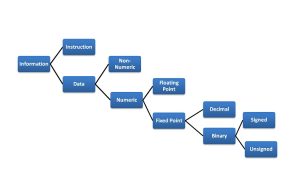Contemporary technology refers to the modern tools, systems, and methods developed and used to solve problems, improve efficiency, and enhance various aspects of life and business. It covers a broad range of advancements that have emerged in the 21st century, driving progress across industries. Here’s a detailed breakdown of contemporary technology and its main types.
Table of Contents
Toggle
-
Artificial Intelligence (AI) and Machine Learning (ML)
Definition: Artificial Intelligence (AI) refers to the simulation of human intelligence by machines, enabling them to perform tasks that typically require human cognition such as decision-making, problem-solving, and speech recognition.
Artificial Intelligence is an emerging branch of computer science, which interprets the means and method of making computers think like human beings. In short, It is the process of integrating human behavior into machines.
Advantages of AI and ML are used in various sectors:
- Increased Efficiency: AI and ML automate repetitive tasks and processes, reducing human labor and time, which boosts productivity.
- Better Decision-Making: AI-powered tools analyze vast amounts of data to help make informed decisions quickly and accurately.
- Enhanced Personalization: ML algorithms can personalize user experiences (e.g., in e-commerce or media streaming) by learning user preferences and behaviors.
- Improved Healthcare: AI aids in faster diagnoses, predictive analytics for disease prevention, and personalized treatment plans.
- Cost Reduction: Automation of business processes using AI reduces operational costs, especially in industries like manufacturing and customer service.
Types of AI:
Narrow AI: Designed for a specific task (e.g., virtual assistants like Siri, or Alexa).
General AI: Theoretical AI that could perform any intellectual task a human can do.
Superintelligent AI: An AI that surpasses human intelligence (currently theoretical).
-
Blockchain Technology
Definition: Blockchain is a decentralized, distributed ledger technology that records transactions across multiple computers, ensuring transparency, security, and immutability. It is the underlying technology behind cryptocurrencies like Bitcoin and Ethereum.
Advantages of Blockchain Technology:
- Enhanced Security: Blockchain’s decentralized and encrypted nature makes it resistant to tampering, providing high levels of data integrity.
- Transparency: All transactions in a blockchain are recorded in a distributed ledger, making them fully transparent and traceable.
- Reduced Costs: By eliminating intermediaries (such as banks or brokers), blockchain reduces transaction costs, especially in industries like finance and supply chain.
- Increased Efficiency: Blockchain streamlines business processes like cross-border payments and smart contracts, enabling faster and more efficient operations.
- Improved Trust: Blockchain fosters trust in industries where multiple parties rely on shared data, such as supply chains and healthcare.
Types of Blockchain:
Public Blockchain: Anyone can join and participate (e.g., Bitcoin, Ethereum).
Private Blockchain: Restricted and permissioned, typically used by organizations.
Consortium Blockchain: Controlled by a group of organizations working together.
-
5G Connectivity
Definition: 5G is the fifth generation of mobile network technology, offering faster speeds, lower latency, and more reliable connections compared to previous generations. It’s a crucial enabler for other technologies like the Internet of Things (IoT) and autonomous vehicles.
Advantages of Connectivity:
- Faster Speeds: 5G networks provide data transfer rates up to 100 times faster than 4G, allowing for quicker downloads and smoother streaming.
- Lower Latency: The ultra-low latency of 5G enables real-time communication, essential for applications like autonomous vehicles and remote surgeries.
- Greater Connectivity: 5G can connect more devices per square kilometer, supporting the growth of the Internet of Things (IoT) and smart city infrastructure.
- Improved Mobile Experiences: Users can experience smoother, faster browsing, video conferencing, and gaming on mobile devices.
- Enablement of Advanced Technologies: Technologies like augmented reality (AR), virtual reality (VR), and autonomous driving require high-speed, low-latency connections, which 5G supports.
Types of 5G Technology
Low-Band 5G: Provides wide coverage with slower speeds but higher reliability.
Mid-Band 5G: Balances speed and coverage.
High-Band 5G (mmWave): Delivers ultra-fast speeds with limited range and higher infrastructure costs.
-
Cloud Computing
Definition: Cloud computing delivers computing services—servers, storage, databases, networking, software, analytics, and intelligence—over the internet (“the cloud”). It allows for scalable resources, cost-effectiveness, and remote accessibility.
Advantages of Cloud Computing:
- Scalability: Cloud services allow businesses to scale their computing resources up or down based on demand, providing flexibility and cost-efficiency.
- Cost Savings: Cloud computing allows businesses to avoid the large capital expenditures required for hardware and infrastructure.
- Remote Accessibility: Cloud platforms allow users to access data and applications from anywhere worldwide, promoting remote work and collaboration.
- Disaster Recovery: Cloud storage provides robust backup and disaster recovery options, ensuring business continuity in case of data loss.
- Automatic Updates: Cloud service providers handle software updates and maintenance, reducing the burden on IT departments.
Types of Cloud Computing:
Public Cloud: Services offered over the internet by third-party providers (e.g., AWS, Google Cloud).
Private Cloud: Exclusively used by a single organization.
Hybrid Cloud: A combination of public and private clouds, offering more flexibility.
-
Edge Computing
Definition: Edge computing brings computation and data storage closer to the devices that collect data, rather than relying on a centralized cloud. This reduces latency and allows for real-time data processing.
Advantages of Edge Computing:
- Reduced Latency: Edge computing processes data closer to the source, significantly reducing the time it takes to respond to data inputs, which is essential for real-time applications.
- Bandwidth Efficiency: By processing data locally, edge computing reduces the amount of data sent to centralized cloud servers, minimizing bandwidth usage.
- Enhanced Security: Since sensitive data can be processed and stored locally, it reduces the risk of exposure to external attacks during transmission.
- Real-Time Data Processing: It enables immediate data analysis, which is vital for applications like autonomous vehicles, industrial IoT, and smart cities.
- Cost Savings: Reducing data transmission to centralized servers lowers cloud service costs, particularly for IoT deployments with numerous devices.
Types of Edge Computing:
Device Edge: Data is processed directly on the device (e.g., smartphones, sensors).
Network Edge: Processing is done at a local network hub before sending data to the cloud.
Enterprise Edge: Data processing occurs on-premises but close to the end-user device.
-
Quantum Computing
Definition: Quantum computing utilizes the principles of quantum mechanics to perform calculations much faster than classical computers. It processes information in qubits (quantum bits), which can exist in multiple states simultaneously, vastly increasing computing power.
Advantages of Quantum Computing:
- Solving Complex Problems: Quantum computers can solve problems that are currently intractable for classical computers, such as complex simulations for drug discovery or material science.
- Faster Processing: Quantum computing’s ability to process multiple states simultaneously enables faster problem-solving for optimization and cryptography.
- Revolutionary in Cryptography: Quantum encryption techniques are expected to be far more secure than current methods, offering stronger protection for sensitive data.
- Advancements in Research: Quantum computing can lead to breakthroughs in areas like climate modeling, supply chain optimization, and financial risk analysis.
- Improved Machine Learning: Quantum computers have the potential to enhance machine learning algorithms, leading to more accurate and faster AI models.
Types of Quantum Computing:
Quantum Annealing: Optimizes problems by finding the best solutions among many possibilities.
Gate-Based Quantum Computing: General-purpose quantum computing, capable of executing any algorithm.
-
Internet of Things (IoT)
Definition: IoT refers to the network of interconnected physical devices that can collect, exchange, and act on data. These “smart” devices range from home thermostats and wearables to industrial sensors.
Advantages of IoT:
- Automation: IoT enables devices to communicate and act autonomously, reducing the need for human intervention in processes like home automation and industrial operations.
- Real-Time Monitoring: IoT devices can monitor and report data in real-time, helping industries like healthcare, agriculture, and logistics optimize performance and maintenance.
- Cost Reduction: Predictive maintenance, enabled by IoT, reduces the likelihood of equipment failure, lowering repair costs and downtime.
- Improved Efficiency: IoT devices optimize operations by analyzing data from connected devices and systems, enabling smarter resource use.
- Enhanced User Experience: IoT in smart homes and wearables provides users with personalized, convenient, and connected experiences.
Types of IoT:
Consumer IoT: Devices like smartwatches, and smart home gadgets.
Industrial IoT (IIoT): Used in manufacturing, energy, and transportation industries.
Infrastructure IoT: Large-scale systems like smart grids, and traffic management.
-
Augmented Reality (AR) and Virtual Reality (VR)
Definition: AR enhances the real-world environment by overlaying digital information, while VR immerses users in a completely virtual environment. Both technologies are reshaping industries like entertainment, healthcare, and education.
Advantages of AR & VR:
- Enhanced Learning and Training: AR and VR offer immersive learning experiences for industries like healthcare, the military, and education by simulating real-life scenarios.
- Improved User Engagement: AR/VR technologies provide interactive, engaging experiences for users, particularly in gaming, retail, and tourism.
- Cost Savings in Training: By using VR simulations, industries can reduce the costs associated with traditional training, such as travel and equipment expenses.
- Remote Collaboration: VR environments allow for virtual meetings, where individuals can interact in a simulated space, enhancing collaboration across geographical boundaries.
- Boosted Sales in Retail: AR lets customers visualize products in their environments before making purchases, increasing buyer confidence and reducing returns.
Types of AR/VR:
Augmented Reality: Combines real-world and digital elements (e.g., Pokémon Go).
Virtual Reality: Fully immersive digital environments (e.g., Oculus Rift).
Mixed Reality (MR): Integrates real and virtual worlds, allowing interactions between the two.
-
Cybersecurity
Definition: Cybersecurity/Computer Security involves protecting systems, networks, and data from cyberattacks, unauthorized access, and damage. As digital transformation accelerates, the need for robust cybersecurity measures has become more reliable.
Advantages of Cybersecurity:
- Protection from Cyber Threats: Cybersecurity tools safeguard organizations and individuals from a wide range of cyber threats, including malware, ransomware, phishing, and data breaches.
- Data Privacy and Integrity: Cybersecurity ensures that sensitive data remains confidential and unaltered, crucial for sectors like finance, healthcare, and government.
- Regulatory Compliance: Businesses can meet legal requirements and avoid penalties related to data protection regulations (e.g., GDPR, HIPAA) through effective cybersecurity measures.
- Safeguards Remote Work: With more people working remotely, cybersecurity helps protect networks and devices from being compromised outside of the traditional office environment.
- Reduced Risk of Financial Loss: By preventing security breaches and attacks, cybersecurity helps companies avoid the financial and reputational damage associated with data leaks and system downtime.
Types of Cybersecurity:
Network Security: Protecting networks from intruders (e.g., hackers, malware).
Application Security: Ensuring software and apps are secure from threats.
Information Security: Protecting data integrity and privacy.
Contemporary technology is a broad spectrum of innovations, each playing a critical role in shaping our present and future. These technologies, whether through AI, blockchain, 5G, or quantum computing, are interwoven into various industries, driving efficiency, security, and creativity. As these technologies continue to evolve, their impact on society and the global economy will only become more profound.








2 Responses
it is use full knowledg
Thank you